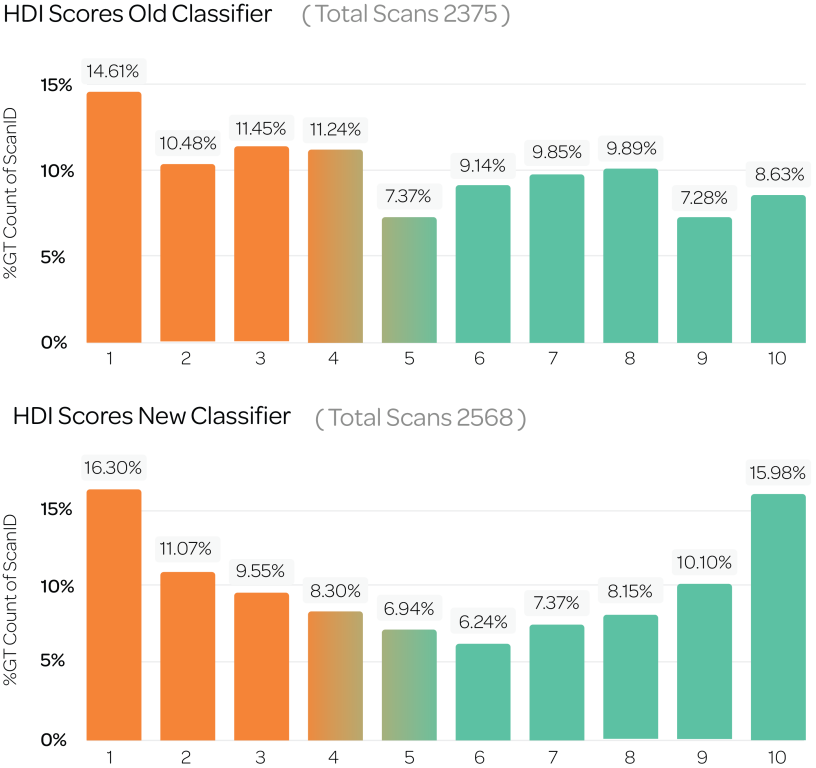
Continuous Improvement For HT Vista Canine Cancer Screening Tool
HT VET, the creator of the HT Vista, a breakthrough non-invasive screening tool for lumps & bumps in dogs, reports a trajectory of continuing improvements in performance since its launch, through refined algorithms and advancements in machine learning. Vets and vet nurses are invited to learn more about how the device can be used in practice for early cancer detection and better treatment outcomes at HT Vista’s stand F67 at London Vet Show on 14th and 15th November.
The continuous improvement of the HT Vista device’s algorithms has resulted in increased sensitivity, specificity and accuracy, putting it on a par with gold-standard screening tools used in human medicine. Effectiveness as a screening tool has also risen as the results have become more decisive rather than evenly spread, and the probability of ruling out cancer for the most common tumours has increased.
It is estimated that about 50% of all dogs over 10 years of age will develop cancer and around a third of those are cutaneous masses.1 HT Vista’s heat diffusion imaging technology offers a real-time way to screen those masses to identify which are benign and likely to require no further treatment. An HT Vista score between 5 and 10 suggests that the mass is likely to be benign. A score between 1 and 4 indicates a higher risk of cancer and that further diagnostics may be necessary.
Initial validation studies and clinical trials2,3 performed in 2020 and 2022 demonstrated promising results for the device, which launched in the UK in 2023. Since then, HT Vista’s sensitivity and specificity—the ability to rule out or rule in cancer—have been enhanced as the algorithms constantly improve. Sensitivity has risen from 85 to 90 percent, while the specificity has increased from 62 to 71 percent. The device has consistently maintained an average negative predictive value (NPV) of 98 percent, meaning there is a high level of confidence that a mass is likely to be benign.
New Classifier
Dermal and subcutaneous growths can originate from various tumour types4.HT Vista’s algorithms have been trained and are particularly accurate when focusing on the most common. The device offers 90 percent accuracy for lipomas, 92 percent accuracy for mast cell tumours and 91 percent accuracy for soft tissue sarcomas.
An ideal screening tool returns results at the extremes. The conclusiveness of the HT Vista results has seen significant development, with results showing a stronger distribution at the poles and the majority of results now representing a very high or low probability of the mass showing benign features. This offers vets clearer answers with more decisive results. (Figure 1)
<x axis label: Heat Diffusion Score (1=highest risk – 10= highest probability of benign)>
Figure 1.
Comparing Distribution of HT Vista Heat Diffusion Scores
Between Old and New Classifier
As a decision support tool, HT Vista provides clear guidance based on a probability scale, highlighting its strength in ruling out cancer for the most common tumours. For instance, in 118 cases with a score of 10 (highest probability of benign), no cancer was found, while in 110 cases with a score of 1 (highest risk), 88% were correctly identified as either mast cell tumours (MCT) or soft tissue sarcomas. While 13 of these were, in actuality, benign lipomas or cysts, further diagnostics ensured peace of mind when they turned out to be non-cancerous. (Figure 2)
Another observation is that inflammatory processes can sometimes mimic the behaviour of tumours with malignant features. As a result, HT Vista may detect benign cysts with inflammation across the HDI spectrum. While no screening tool is perfect, the results highlight HT Vista's ability to guide clinicians toward better outcomes, all while reducing the invasiveness and costs associated with the incumbent diagnostic method.
HT Vista is also comparable to gold-standard screening tools used in human medicine, such as mammography, Faecal Occult Blood Testing (FOBT) and Cervical Cancer Screening which identify specific cancers before symptoms fully manifest. HT Vista is on a par with these screening tools for every performance metric of specificity, sensitivity, NPV and PPV for dermal and subcutaneous masses, aiming to flag malignancies before they pose a significant risk to the animal’s health and empower vets to make early, informed decisions about cancer treatment.
Dr Liron Levy-Hirsch, Managing Director at HT Vista, comments, “HT Vista represents a breakthrough in non-invasive cancer screening, enabling vets to evaluate dermal and subcutaneous masses quickly, confidently and painlessly, rather than choose to ‘wait & see’. With the technology’s ever-improving accuracy, vet practices can now access an indispensable, cutting-edge tool to provide pet owners with peace of mind and compassionate care for their four-legged companions.”
Visit HT Vista on stand F67 at London Vet Show on 14th-15th November to find out more about how the HT Vista device can aid early cancer detection in practice, or visit https://www.ht-vet.com/
More from HT Vista
- New survey reveals 62% of canine lumps go undiagnosed in veterinary practice
- HT Vista launches educational page to support pet owners in canine cancer awareness
- HT Vista offers exclusive discounts and giveaways at BVA Live 2025
- HT Vista launches free academy to support users following the launch of their new diagnostic technology
- HT Vista launches new product update with diagnostic capability for lumps on dogs

 1 year ago
1 year ago  1438 views
1438 views
